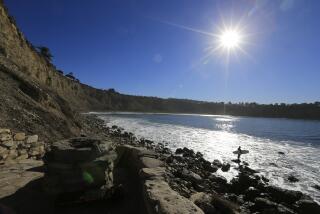Bergeson Tries Anew on Beach Suits : Effort to Limit Community Liability Has Failed Twice
- Share via
SACRAMENTO — Despite the defeat of two earlier bills, Sen. Marian Bergeson (R-Newport Beach) introduced new legislation Monday that would limit large lawsuits for injuries resulting from “natural conditions” at public beaches and other recreational areas.
Bergeson said she introduced the measure on the first day of the 1987-88 legislative session to signal that “it is one of those issues we won’t let go away.”
Officials of Southern California beach communities, who strongly backed Bergeson’s earlier bills on the issue, say they have been bombarded with lawsuits since the City of Newport Beach was slapped with a $6-million verdict in 1984. The verdict was made in a lawsuit by a Claremont teen-ager who was paralyzed after diving into shallow water and striking a sand bar.
Earlier this year, officials in beach cities characterized restoration of governmental immunity that previously shielded them from such lawsuits as their top legislative priority.
But critics noted that Newport Beach never posted warning signs about the sand bars until after the verdict, although there have been hundreds of similar injuries on beaches in the vicinity in recent years.
Members of the Senate Judiciary Committee, arguing that beach communities have a responsibility to protect the public from known dangers, have twice voted down attempts by Bergeson to restore the immunity--in 1984 and 1985.
The bill Bergeson introduced Monday says, “The natural condition itself is the basis of the immunity,” and adds that “no act or omission of a public entity or public employee shall be considered when applying this immunity.”
Essentially, Bergeson’s bill, like the two earlier ones, would reverse a state appellate court ruling, allowed to stand by the state Supreme Court in 1982, that stripped away the governmental immunity. Justices said the longstanding immunity for public entities’ “natural conditions” does not apply in areas where improvements have been made and municipal services such as police and lifeguards have been provided.
The ruling grew out of a little-noticed lawsuit against the City of San Diego stemming from a 1978 riptide drowning at Black’s Beach, a popular spot for nude sunbathers.
But it was the Newport Beach verdict, made possible by that ruling, that triggered scores of other lawsuits up and down the coast.
“In some cases, they (beach cities) are actually settling . . . just to save them the difficulty of going through with the litigation,” Bergeson said.
Bergeson, who has argued that taxpayers should not be held responsible for injuries when beachgoers and others take foolish chances, said the settlements are “certainly a needless expenditure of taxpayer funds.”
Bergeson said she did not know until after she had introduced her bill that a $3-million claim was filed Monday against San Clemente, Orange County and the state for a diving accident at San Clemente State Beach last summer.
The City of San Clemente--one of the first in Orange County to post warning signs regarding pier pilings, submerged rocks, rip currents and other hazards--was one of the few on the Orange County coast that had not faced that sort of lawsuit since the 1984 verdict against Newport Beach.
More to Read
Sign up for Essential California
The most important California stories and recommendations in your inbox every morning.
You may occasionally receive promotional content from the Los Angeles Times.










